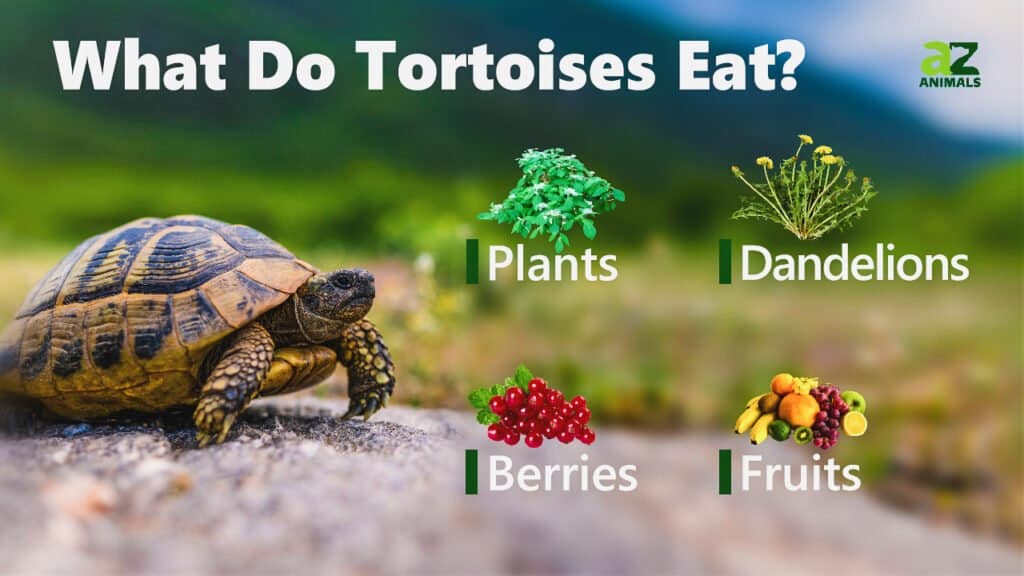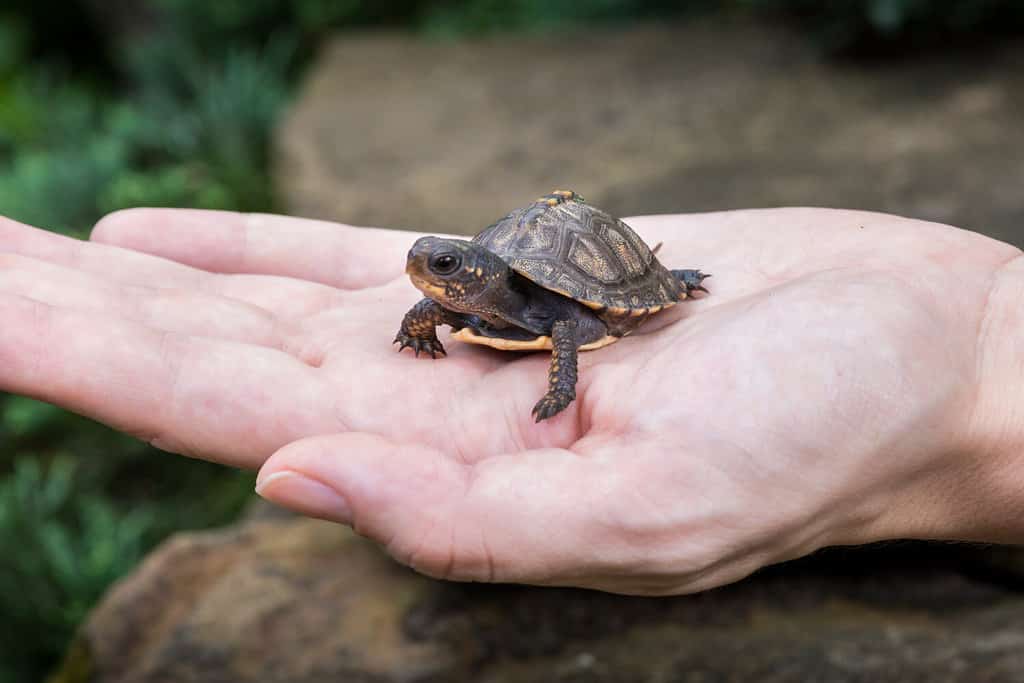Turtle is a big word. It’s both an animal and a term.
Turtle is a term to describe all 200 species that fall into the ancient testudines group. Tortoises and turtles are two of those animals. Certain species, like box turtles, look like tortoises with high domed shells. But looks can be deceiving.
How a tortoise spends its day is very different from how a box turtle does things. Keep reading as we unveil the differences between a box turtle vs. tortoise.
Comparing Box Turtle vs. Tortoise
| Box Turtle | Tortoise | |
|---|---|---|
| Features | High domed shell Dark underside Webbed feet | High domed shell Yellow underside Stumpy elephant feet |
| Habitat | Moist environments Terrestrial By bodies of water | Dry environments No watering holes Places with lots of low lying vegetation |
| Diet | Opportunistic omnivore Carnivorous as juvenilles | Opportunistic omnivore Primarily herbivorous |
| Lifespan | Can live past 50 in the wild | Can live past 50 in the wild |
| Social behaviors | Lives in groups called a bale 3-4 members in each bale Solitary for part of their life Mildly aggressive mating behaviors | Solitary entire life except for mating season Exceptionally aggressive mating behaviors |
Comparing Box Turtle vs. Tortoise: Key Differences

Tortoises and box
turtles have domed shape shells
.
©iStock.com/GoDogPhoto
The key differences between a box turtle and a tortoise are their features, habitat, diet, lifespan, and social behaviors.
Both animals have a high domed shell, but tortoises have elephant-like feet. Even though box turtles live on the land, they thrive in moist situations. It’s normal to see a box turtle hanging out near a river’s edge, but you won’t find a tortoise there. They get all the water they need from cactus pads.
Both animals enjoy eating plants, but tortoises stick to dry vegetation. Finally, tortoises and box turtles can lead long lives past 50 years in the wild. However, a tortoise will spend most of that time alone, while a box turtle might be in a group of three to four members, which is called a bale.
What else should you know about a box turtle vs. tortoise? Lots! Keep reading to find out.
Comparing Box Turtle vs. Tortoise: Distinct Features

Box turtle’s ribs and vertebrae fuse to their shells.
©Studio DMM Photography, Designs & Art/Shutterstock.com
Box turtles have two distinct features. First, they have a pelvic girdle. The pelvic girdle sits right inside their rib cage. Second, box turtles’ ribs and vertebrae are fused to their shells. It gives them a compressed anatomical structure and a unique lumbering swagger.
You can also look at their feet to tell the box turtle vs. tortoises apart. A tortoise’s foot is more evolved for trekking long distances across the land. Turtles, even terrestrial ones like box turtles, tend to have webbed feet.
Since tortoises are burrowers, their feet resemble an elephant’s foot, only miniature. Gopher tortoises make burrows that are, on average, over 6 feet deep. That’s why gopher tortoise feet have thick pads and are stumpy. At the same time, box turtles have webbing reminiscent of sea turtles’ flippers.
Comparing Box Turtle vs. Tortoise: Shell Features
Looking at the shell to tell turtles apart from tortoises is helpful with aquatic species. But, it’s tricky with terrestrial turtles, like box turtles.
Aquatic turtles have a smooth, streamlined shell. Tortoises have a domed, defined shell.
Box turtles, and Sonoran mud turtles, are often mistaken for tortoises because of their shell shape. Unlike their turtle relatives, box turtles have a high domed upper shell. Since shell shape doesn’t help with identification, you can look at the shell’s color markings for clues.
The underside of the box turtle provides a lot of clues. The underside, or plastron, is usually a dark brown or black color.
Tortoise males will have a concave plastron, and females will have a convex plastron. The skin area will also be brown or black with light markings. Depending on the tortoise species, they will probably have a yellow plastron for both sexes.
Comparing Box Turtle vs. Tortoise: Habitat

Box turtles live on land but like being by
bodies of water
.
©iStock.com/zrfphoto
Box turtles are terrestrial, but enjoy moist environments. They thrive in various vegetative habitats, including meadows, woodlands, and forests. The only box turtle that lives in the water is the aquatic box turtle.
Tortoises are turtles that always live on land. Their bodies aren’t evolved for water. A lot of tortoises need a habitat with trees. However, too many trees can be a problem. There needs to be enough sunlight to feed the low-growing plants they eat. That’s why gopher tortoises love living in longleaf pine forests where the sun can shine past treetops.
Comparing Box Turtle vs. Tortoise: Diet

Tortoises are usually opportunistic eaters who avoid water. They can get all the water they need from the plants they eat, so it’s rare for a tortoise to seek out a watering hole.
Different tortoise species have different dietary needs. However, they tend to be vegetarians.
Gopher tortoises are omnivores with a primarily herbivorous diet. They eat insects, crabs, and low-growing plants. Tortoises love eating berries, grass, mushrooms, flowers, cactus pads, and juicy apples.
Box turtles are omnivores, eating a diet consisting of insects, amphibians, and plants. During the early stages of their life, box turtles are more carnivorous. They’ll hunt in streams and ponds and feed on the eggs of aquatic animals. As they grow up, they start to adopt a more vegetarian lifestyle. Plant roots, berries, and flowers are all staples of the box turtles’ diet.
Comparing Box Turtle vs. Tortoise: Lifespan and Social Behaviors
A group of tortoises is called a creep, but you probably won’t see a creep in the wild. It’s rare to find more than one tortoise in a burrow. The exception would be a nest of hatchlings.
Tortoises can easily live for over 50 years in the wild. Their exact lifespan depends on the species. For instance, gopher tortoises can live for 60 years. They’ll spend most of that time by themselves, with the mating season being the only exception.
It can take a couple of decades before a tortoise is ready to mate. During mating season, the normally docile animal takes on a more aggressive personality. Tortoises have species-specific mating behaviors that are usually rough or aggressive. When mating is done, the tortoise goes back to living a solitary, peaceful life.
Alternatively, a group of box turtles is called a bale. You can usually spot a bale right after a heavy rain. Eastern box turtles tend to live in bales of three to four. However, they can spend years of their life as solitary transients, trying to find the perfect place to fit in.
Box turtles can live past 50 years in the wild as well. During mating season, competing box turtle males may spar with each other. If sparring occurs, one of the males will begin biting the other male’s shell. The bites are so gentle they don’t cause any damage. Changes in behavior during mating season are commonplace in tortoises, turtles, and many other animal species.
Bonus: Do Box Turtles Make Good Pets?

Box turtles can be great pets for experienced pet owners.
©JasonYoder/Shutterstock.com
Box turtles can be good pets for people who can appreciate the complexity of their care requirements. That is why turtles shouldn’t be given as pets to children. Turtles, especially those taken from the wild, can become stressed easily and won’t enjoy being carried around or bothered all of the time. They need to be fed at least every other day and their cage needs to be cleaned weekly. While they usually don’t bite – they may if they are stressed and handled too much. Turtles crave peace! They don’t want stress in their lives and they love consistency. Once your box turtle gets used to you and the calm, dependable care you provide – they may enjoy following you around outside. It is best to purchase your pet box turtle from a reputable breeder instead of capturing one in the wild. For more information, check out our Pet Turtle Guide: What You Need to Know.
The photo featured at the top of this post is © Jenny Sturm/Shutterstock.com
Thank you for reading! Have some feedback for us? Contact the AZ Animals editorial team.






